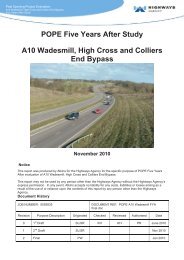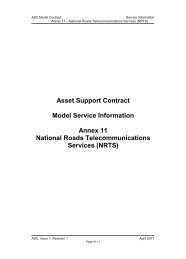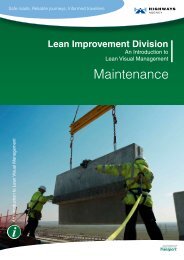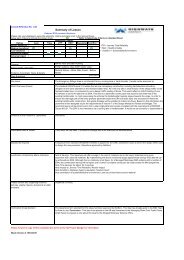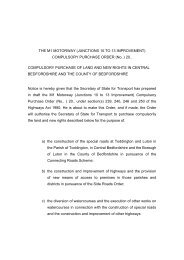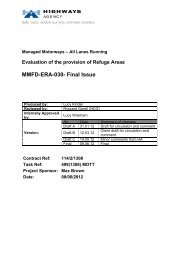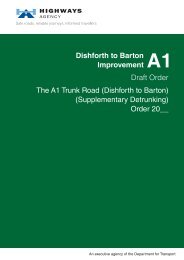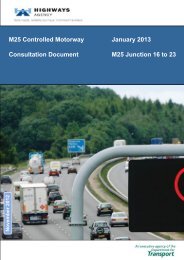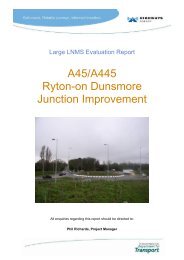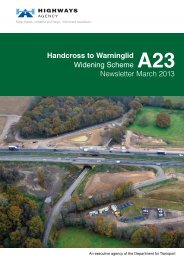A6 RUSHDEN – HIGHAM FERRERS BYPASS ... - Highways Agency
A6 RUSHDEN – HIGHAM FERRERS BYPASS ... - Highways Agency
A6 RUSHDEN – HIGHAM FERRERS BYPASS ... - Highways Agency
Create successful ePaper yourself
Turn your PDF publications into a flip-book with our unique Google optimized e-Paper software.
growth between 1990 and 2008 was 46%, well in excess of the growth predicted inthis COBA 11.4 forecast.2.15 If the predicted flows are changed to take into account the actual 46% growth forNorthamptonshire, then the figures in Table 2.3 become modified to those shownin Table 2.4 below. These show that considerable problems remain, in particularon the bypass south of John Clark Way. Therefore the low growth built into COBA11.4 is by no means the only reason for the mis-match between prediction andobservation.Table 2.4 <strong>–</strong> Predicted and Actual Flows, assuming Observed Regional GrowthLinkWithoutschemePredicted Actual Actual / PredictedWithschemeWithoutschemeWithschemeWithoutschemeWithschemeA5028 (old <strong>A6</strong>), N of Higham Ferrers 14,200 5,900 19,800 9,900 40% 69%A5028 (old <strong>A6</strong>), N of Rushden 17,800 15,400 20,800 14,000 17% -9%A5028 (old <strong>A6</strong>), S of Rushden 9,600 8,300 14,400 7,100 49% -14%A45, SW of <strong>A6</strong> 31,200 30,800 29,200 29,900 -6% -3%B645 Kimbolton Rd 6,700 4,700 7,300 5,100 9% 10%A5001 John Clark Way - 7,800 - 4,800 - -39%<strong>A6</strong> bypass, S of A45 - 10,700 - 13,100 - 23%<strong>A6</strong> bypass, N of John Clark Way - 9,200 - 15,100 - 64%<strong>A6</strong> bypass, S of John Clark Way - 2,700 - 11,000 - 304%<strong>A6</strong> bypass, N of A5028 Bedford Rd - 1,700 - 7,800 - 360%2.16 From Table 2.3, the predicted flow on the combined new and old <strong>A6</strong> at thenorthern end of the scheme was 14,700 vpd, of which 65% would use the bypass.In reality however, the combined flow is 23,300 vpd, of which 57% uses thebypass. The proportion using the bypass here is a little higher than predicted.2.17 At the southern end of the scheme, the predicted combined flow was 8,900 vpd, ofwhich 17% would use the bypass. In reality, the combined flow is 14,900 vpd, ofwhich 52% uses the bypass. The proportion using the bypass is therefore verymuch higher than predicted (although still only about half the total).2.18 At the middle of the scheme, just north of Rushden, the predicted combined flowwas 21,800 vpd, of which 38% would use the bypass. In reality the combined flowis 29,100, of which 52% uses the bypass. This proportion is substantially higherthan predicted.2.19 Thus in all three cases, the total combined flow has been higher than predicted,and the proportion using the bypass has been higher than predicted. Thediscrepancy is most serious in the south. Evidently the traffic model used toproduce flows for COBA was giving unrealistic results.2.20 It may also be noted that much of the new development has occurred in the south,that is the area where actual flows most exceed the predictions. Possibly this wasnot foreseen in the scheme forecasting. Developments include housing, industry,and retail, including a large ASDA store which opened in November 2006 (see24



